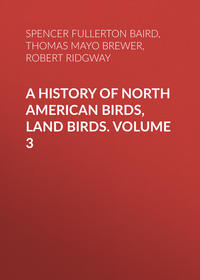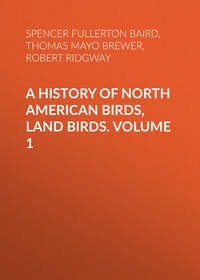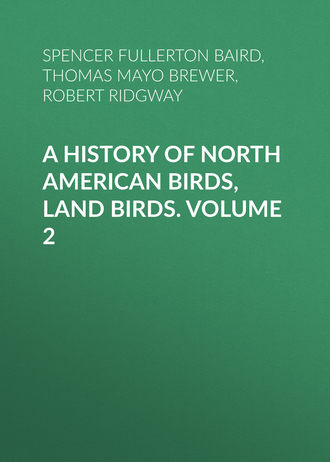 полная версия
полная версияA History of North American Birds, Land Birds. Volume 2
Dr. Cooper reports this species as near San Diego about March 25. Large flocks were then passing northward. During the day they kept among the grass, and were rather shy and silent. They seemed to have a good deal of the habits of the Passerculus, and to differ much in their gregariousness, their migratory habits, and their general form, from the other Melospizæ. Dr. Cooper did not meet with any of these birds in the Colorado Valley, nor has he seen or heard of any having been found in California during the summer. The M. lincolni has been found breeding up to high Arctic latitudes. It was met with by Mr. Kennicott at Fort Simpson and at Fort Resolution. At the latter place its nests were found between the 2d and the 14th of June. They were also obtained in May, June, and July, at Fort Simpson, by Mr. B. R. Ross, and at Yukon River, Fort Rae, Nulato, and other localities in the extreme northern regions, by Messrs. Reid, Lockhart, Clarke, Kirkby, and Dall. On Mt. Lincoln, Colorado, above eight thousand feet, Mr. Allen found this Sparrow very numerous.
This Finch was found by Salvin about the reeds on the margin of Lake Dueñas, Guatemala, in February, but was not common. It is common, in the winter months, near Oaxaca, Mexico, where it was taken by Mr. Boucard.
Mr. Kennicott saw its nest June 14. This was on the ground, built in a bunch of grass in rather an open and dry place, and containing five eggs. The female permitted him to approach very close to her, until he finally caught her on the nest with his beating-net. Another nest was placed in a bunch of grass growing in the water of a small grassy pond. The nest contained four eggs and one young bird.
The nest and eggs of this species had been previously discovered by Dr. Hoy, near Racine. This is, I believe, the first instance in which it was identified by a naturalist, as also the most southern point at which it has ever been found. These eggs measure .74 by .60 of an inch. They have a pale greenish-white ground, and are thickly marked with dots and small blotches of a ferruginous-brown, often so numerous and confluent as to disguise and partially conceal the ground.
Melospiza palustris, BairdSWAMP SPARROWFringilla palustris, Wilson, Am. Orn. III, 1811, 49, pl. xxii, f. 1.—Aud. Orn. Biog. I, 1831, 331; V, 508, pl. lxiv. Fringilla (Spiza) palustris, Bonap. Obs. Wilson, 1825, No. 105. Passerculus palustris, Bonap. List, 1838.—Ib. Conspectus, 1850, 481. Ammodromus palustris, Aud. Syn. 1839.—Ib. Birds Am. III, 1841, 110, pl. clxxv. Melospiza palustris, Baird, Birds N. Am. 1858, 483.—Samuels, 323. ? Fringilla georgiana, Lath. Index Orn. I, 1790, 460 (perhaps Peucæa æstivalis).—Licht. Verz. 1823, No. 251. Fringilla (Ammodromus) georgiana, Nutt. Man. I, (2d ed.,) 1840, 588.
Sp. Char. Middle of the crown uniform chestnut; forehead black; superciliary streak, sides of head and back, and sides of neck, ash. A brown stripe behind the eye. Back with broad streaks of black, which are edged with rusty yellow. Beneath whitish, tinged with ashy anteriorly, especially across the breast, and washed with yellowish-brown on the sides. A few obsolete streaks across the breast, which become distinct on its sides. Wings and tail strongly tinged with rufous; the tertials black, the rufous edgings changing abruptly to white towards the end. Length, 5.75; wing, 2.40.
Female with the crown scarcely reddish streaked with black, and divided by a light line. Young conspicuously streaked beneath the head, above nearly uniform blackish.
Hab. Eastern North America from the Atlantic to the Missouri; north to Fort Simpson.
In autumn the male of this species has the feathers of the crown each with a black streak; and the centre of the crown with an indistinct light stripe, materially changing its appearance.
The forehead is usually more or less streaked with black.
In the uncertainty whether the Fringilla georgiana of Latham be not rather the Peucæa æstivalis than the Swamp Sparrow, I think it best to retain Wilson’s name. It certainly applies as well to the latter, which has the black sub-maxillary streak, and the chin and throat more mouse-colored than in palustris.
Habits. Owing to the residence of this species in localities not favoring frequent visits or careful explorations, and still more to its shy and retiring habits, our writers have not been generally well informed as to the history and general manners of this peculiar and interesting Sparrow. Its irregular distribution, its abundance only in certain and unusually restricted localities, its entire absence from all the surrounding neighborhood, and its secretiveness wherever found, have all combined to throw doubt and obscurity over its movements. Unless purposely looked for and perseveringly hunted up, the Swamp Sparrow might exist in large numbers in one’s immediate neighborhood and yet entirely escape notice. Even now its whole story is but imperfectly known, and more careful investigation into its distribution and general habits will doubtless clear up several obscure points in regard to its movements.
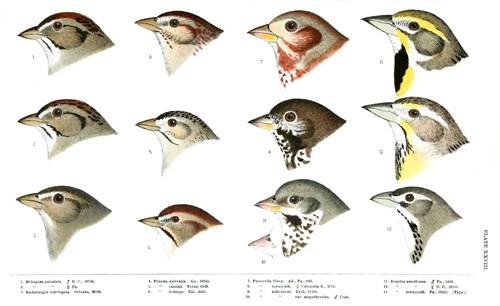
PLATE XXVIII.
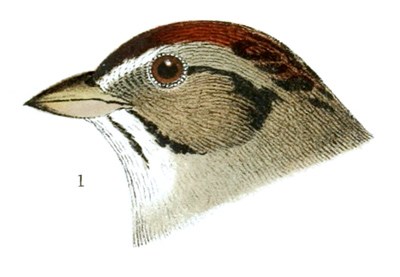
1. Melospiza palustris. ♂ D. C., 38746.
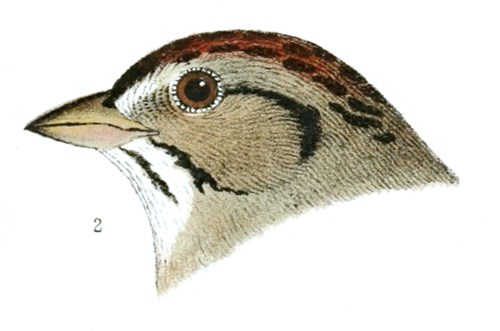
2. Melospiza palustris. ♀ Pa.
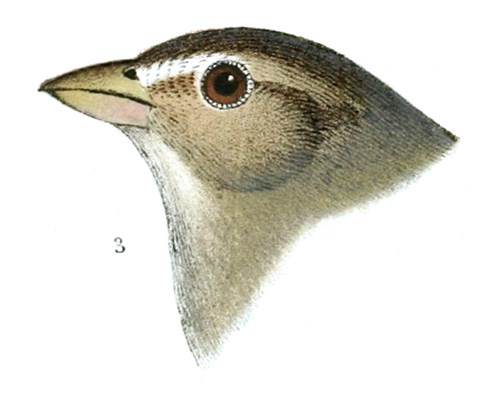
3. Embernagra rufivirgata. Orizaba, 29229.
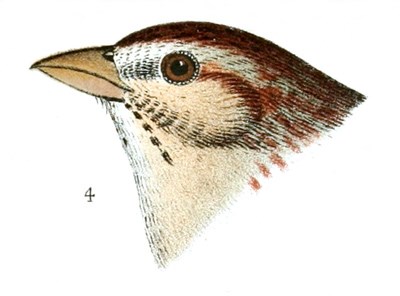
4. Peucæa æstivalis. Ga., 10245.
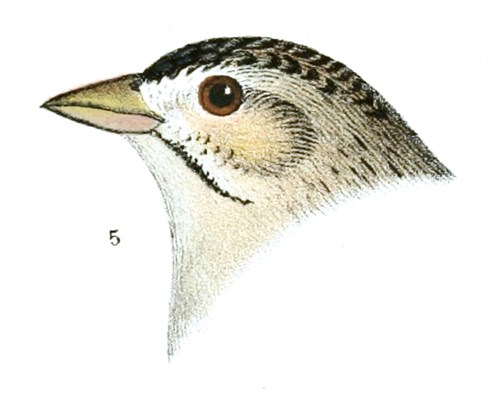
5. Peucæa cassini. Texas, 6329.

6. Peucæa ruficeps. Cal., 6241.
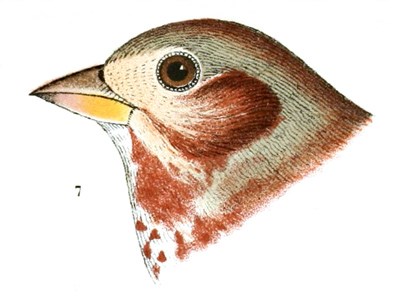
7. Passerella iliaca. Ad., Pa., 846.
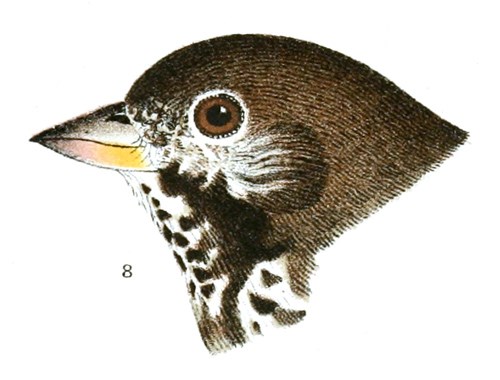
8. Passerella townsendi. ♀ Columbia R., 2874.
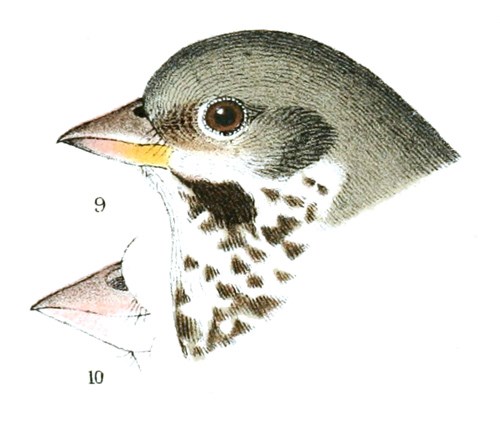
9. Passerella schistacea. Utah, 11234.
10. Passerella schistacea. var. megarhyncha. ♂ Utah.
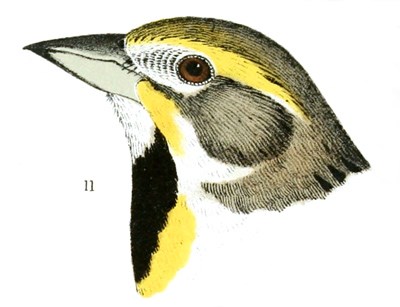
11. Euspiza americana. ♂ Pa., 1459.
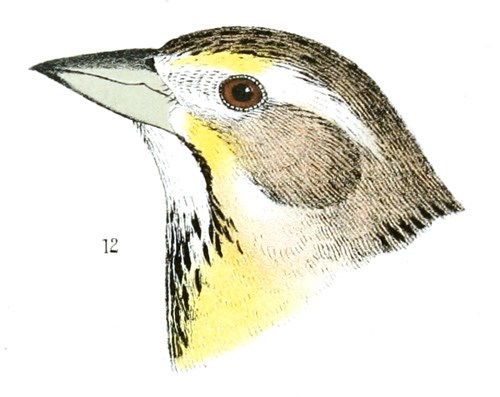
12. Euspiza americana. ♀ D. C., 10133.
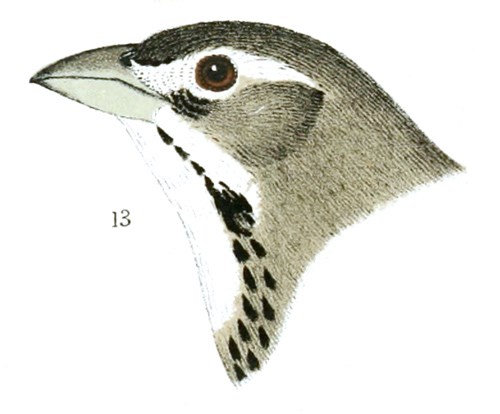
13. Euspiza townsendi. Pa., 10282. (Type.)
From what is now known, we gather that it occurs throughout the eastern portions of North America, from the Southern States, in which it passes the wintry months, to high northern latitudes, where some find their way in the breeding-season, extending as far to the west at least as the Missouri River region.
Three specimens were obtained at Fort Simpson, by Mr. Kennicott, in September, which indicates their probable summer presence in latitude 55°, and their near approach to the Pacific coast at the extreme northwestern portion of their distribution. Audubon also met with them in Newfoundland and in Labrador. They are known to breed as far to the south as Pennsylvania. They have been taken in the eastern portion of Nebraska, and breed in considerable numbers in Southern Wisconsin. Further investigations in regard to its distribution will probably show it to be a much more widely distributed as well as a more abundant bird than has been generally supposed.
Mr. Ridgway writes me that this bird winters in Southern Illinois, and remains there very late in the spring, but he thinks that none remain to breed.
Wilson states that it arrives in Pennsylvania early in April, where it frequents low grounds and river-courses, rears two and sometimes three broods in a season, and returns to the South as the cold weather commences. During the winter, he met with them in large numbers in the immense cypress swamps and extensive grassy flats of the Southern States, along the numerous rivers and rice plantations. These places abounded with their favorite seeds and other means of sustenance, and appeared to be their general places of resort at this season. From the river Trent, in North Carolina, to the Savannah River, and even farther south, Wilson found this species very numerous. They were not found in flocks, but skulked among the reeds and grass, were shy and timorous, and seemed more attached to the water than any others of this family. In April large numbers pass through Pennsylvania northward. Only a few remain behind, and these frequent the swamps and the reedy borders of creeks and rivers. He found their nests built in the ground, in tussocks of rank grass, surrounded by water, with four eggs of a dirty-white ground, spotted with rufous. He has found them feeding their young as late as the 15th of August. Their food seemed to be principally grass-seeds, wild oats, and insects. He supposed them to have no song, and that their only note was a single cheep uttered in a somewhat hoarse tone. They flirt their tails as they fly, seldom or never take to trees, but run and skulk from one low bush to another.
Except in regard to their song, Wilson’s account of their habits, so far as it goes, is quite accurate, although this bird really does have quite a respectable song, and one that improves as the season advances. At first it is only a succession or repetition of a few monotonous trilling notes, which might easily be mistaken for the song of the Field Sparrow, or even confounded with the feebler chant of the socialis, although not so varied as the former, and is much more sprightly and pleasing than the other. Still later its music improves, and more effort is made. Like the Song Sparrow, it mounts some low twig, expands its tail-feathers, and gives forth a very sprightly trill that echoes through the swampy thicket with an effect which, once noticed and identified with the performer, is not likely to be ever mistaken. Nuttall calls this song loud, sweet, and plaintive. It is to my ear more sprightly than pathetic, and has a peculiarly ventriloquistic effect, as if the performer were at a much greater distance than he really is.
Their food, when they first arrive, and that which they feed to their young, consists very largely of insects, principally coleopterous ones, with such few seeds as they can glean. After the breeding-season, when their young can take care of themselves, they eat almost exclusively the ripened seeds of the coarse water grasses and sedges. They are very devoted to their young, and often display great solicitude for their safety, even when able to take care of themselves, and often expose themselves to dangers they carefully avoid at other times, and are thus more easily procured. At all other times they are difficult to shoot, running, as they do, through the grass and tangled thickets, and rarely rising on the wing. They dive from thicket to thicket with great rapidity, and even when wounded have a wonderful power of running and hiding themselves.
Mr. Audubon met with them, during autumn and winter, among the flat sand-bars of the Mississippi, which are overgrown with rank grasses. Though not in flocks, their numbers were immense. They fed on grass-seeds and insects, often wading for the latter in shallow water in the manner of the Tringidæ, and when wounded and forced into the water swimming off to the nearest shelter. He also met with these birds abundantly dispersed in the swamps of Cuyaga Lake, as well as among those along the Illinois River in the summer, and in the winter up the Arkansas River.
Mr. Townsend observed these birds on the head-waters of the Upper Missouri, but did not meet with them beyond.
In Maine, Mr. Boardman gives it as a regular summer visitant at Calais, arriving there as early as March, becoming common in May, and breeding in that locality. Professor Verrill found it in Western Maine, a summer visitant and breeding, but did not regard it as common. From my own experience, in the neighborhood of Boston, I should have said the same as to its infrequency in Eastern Massachusetts, yet in certain localities it is a very abundant summer resident. Mr. William Brewster has found it breeding in large numbers in the marshes of Fresh Pond, where it arrives sometimes as early as the latter part of March, and where it remains until November. In the western part of the State it is more common as a migratory bird, and has not been found, in any numbers, stopping to breed. Mr. Allen never met with any later than May 25. They were observed to be in company with the Water Thrush, and to be in every way as aquatic in their habits. In the autumn he again met with it from the last of September through October, always in bushy marshes or wet places. Mr. McIlwraith states that in the vicinity of Hamilton, Ontario, it is a common summer resident, breeding there in marshy situations. At Lake Koskonong, in Wisconsin, Mr. Kumlien has also met with these birds abundantly in suitable localities, and found their nests and eggs quite plentiful.
Mr. Ridgway has recently found this Sparrow to be a very abundant winter resident in Southern Illinois, where it inhabits swampy thickets, and where it remains until May, but is not known to breed there.
They always nest on the ground, usually in a depression sheltered by a tuft of grass. The nest is woven of fine grass-stems, but is smaller than the nest of M. melodia.
The eggs of this species, usually five in number, have an average measurement of .78 by .60 of an inch. Their ground-color is usually a light green, occasionally of a light clay, marked and blotched with reddish and purplish brown spots, varying in size and number, occasionally forming a confluent ring around the larger end.
Genus PEUCÆA, AudubonPeucæa, Aud. Synopsis, 1839. (Type, Fringilla æstivalis.) Sclater & Salvin, 1868, 322 (Synopsis.)
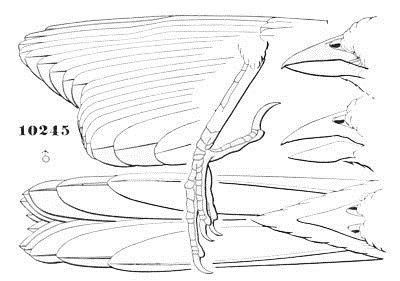
Peucæa æstivalis.
10245 ♂
Gen. Char. Bill moderate. Upper outline and commissure decidedly curved. Legs and feet with the claws small; the tarsus about equal to the middle toe; the lateral toes equal, their claws falling considerably short of the middle one; the hind toe reaching about to the middle of the latter. The outstretched feet reach rather beyond the middle of the tail. The wing is very short, reaching only to the base of the tail; the longest tertials do not exceed the secondaries, while both are not much short of the primaries; the outer three or four quills are graduated. The tail is considerably longer than the wings; it is much graduated laterally; the feathers, though long, are peculiarly narrow, linear, and elliptically rounded at the ends.
Color beneath plain whitish or brownish, with a more or less distinct dusky line each side of the chin. Above with broad obsolete brown streaks or blotches. Crown uniform, or the feathers edged with lighter.
Species and VarietiesCommon Characters. A light superciliary stripe, with a brownish one below it from the eye along upper edge of ear-coverts (not one along lower edge of ear-coverts, as in Melospiza). A narrow blackish “bridle” along side of throat (sometimes indistinct). Crown without a distinct median stripe, and lower parts without markings. Ground-color above ashy, sometimes of a brownish cast; dorsal region and nape with brown blotches, with or without dark centres. Crown blackish-brown streaked with ashy or plain rufous. Beneath plain brownish-white, lightest on the abdomen, darker across jugulum and along sides.
A. Crown plain rufous; interscapulars without distinct black centres, and tertials without whitish border. Blackish “bridle” conspicuous. Bend of wing edged with white.
1. P. ruficeps.
Above olivaceous-ash, interscapulars with broad streaks of dull rufous, the shafts scarcely blackish. Crown bright rufous. Wing, 2.40; tail, 2.70; bill, .29 from forehead, .20 deep; tarsus, .70; middle toe without claw, .55. Hab. California (and Mexico in winter?) … var. ruficeps.
Darker, above brownish-plumbeous, dorsal streaks scarcely rufous, and with distinctly black shaft-streaks; crown darker rufous. Wing, 2.40; tail, 2.60; bill, .34 and .25; tarsus, .77; middle toe, .57. Hab. Mexico (Orizaba; Oaxaca), in summer … var. boucardi.7
B. Crown streaked; interscapulars with distinct black centres; tertials sharply bordered terminally with paler. “Bridle” obsolete; bend of wing edged with yellowish.
2. P. æstivalis. Above uniformly marked with broad streaks or longitudinal blotches of deep rufous; black streaks confined to interscapulars and crown. Tail-feathers without darker shaft-stripe, and without indications of darker bars; the outer feathers without distinct white. Black marks on upper tail-coverts inconspicuous, longitudinal.
The bluish-ash, and chestnut-rufous streaks above sharply contrasted; black dorsal streaks broad. Wing, 2.45; tail, 2.65; bill, .30 and .30; tarsus, .73; middle toe, .60. Hab. Southern States from Florida and Georgia to Southern Illinois … var. æstivalis.
The dull ash and light rufous streaks above not sharply defined; black dorsal streaks narrow. Wing, 2.65; tail, 3.00; bill, .32 and .25; tarsus, .80; middle toe, .63. Hab. Southern border of the Arizona region of Middle Province of United States … var. arizonæ.
Markings badly defined as in the last, but the rufous streaks darker (in summer plumage almost entirely black), with more black on the crown. Wing, 2.55; tail, 2.65; bill, .32 and .25; tarsus, .80; middle toe, .60. Hab. Mexico (Orizaba; Mirador, Colima) … var. botterii.8
3. P. cassini. Above marked everywhere with broad short streaks of pale (not reddish) brown streaks, all black medially. Tail-feathers with distinct blackish shaft-stripe, throwing off narrow, obsolete bars toward the edge of the feathers. Outer tail-feathers distinctly tipped (broadly) and edged with dull white. Black marks on upper tail-coverts very large, transverse. Beneath nearly uniform dull white, scarcely darker along sides and across breast; flanks with broad streaks of blackish-brown. Wing, 2.55; tail, 2.80; bill, .28 and .23; tarsus, .68; middle toe, .55. Hab. Rio Grande, region (San Antonio and Laredo), north to Kansas (Allen).
Peucæa æstivalis, CabanisBACHMAN’S SPARROWFringilla æstivalis, Licht. Verz. Doubl. 1823, 25, No. 254.—Bonap. Conspectus, 1850, 481. Peucæa æstivalis, Cabanis, Mus. Hein. 1850, 132.—Baird, Birds N. Am. 1858, 484. Fringilla bachmani, Aud. Orn. Biog. II, 1834, 366, pl. clxv. Ammodromus bachmani, Bon. List, 1838. Peucæa bachmani, Aud. Syn. 1839.—Ib. Birds Am. III, 1841, 113, pl. clxxvi.—Bon. Consp. 1850, 481 (type). Fringilla æstiva, Nutt. I, (2d ed.,) 1840, 568. “Summer finch, Latham, Synopsis, (2d ed.,) VI, 136.” Nuttall.

Peucæa æstivalis.
Sp. Char. All the feathers of the upper parts rather dark brownish-red or chestnut, margined with bluish-ash, which almost forms a median stripe on the crown. Interscapular region and upper tail-coverts with the feathers becoming black in the centre. An indistinct ashy superciliary stripe. Under parts pale yellow-brownish, tinged with ashy on the sides, and with darker brownish across the upper part of the breast. A faint maxillary dusky line. Indistinct streaks of chestnut along the sides. Edge of wing yellow; lesser coverts tinged with greenish. Innermost secondaries abruptly margined with narrow whitish. Legs yellow. Bill above dusky, yellowish beneath. Outer tail-feathers obsoletely marked with a long blotch of paler at end. Female considerably smaller. Young with rounded dusky specks on the jugulum, which is more ochraceous. Length, 6.25; wing, 2.30; tail, 2.78.
Hab. Georgia; Florida; South Illinois, breeding (Ridgway). (Perhaps whole of Southern States from Florida to South Illinois.)
Specimens from Southern Illinois (Wabash Co., July, 1871; coll. of R. Ridgway) are similar to Florida examples.
Habits. Bachman’s Finch has only been known, until very recently, as a species of a very restricted range, and confined within the limits of the States of South Carolina, Georgia, and Florida. Our principal, and for some time our only, knowledge of its habits was derived from the account furnished by Rev. Dr. Bachman to Mr. Audubon. That observing naturalist first met with it in the month of April, 1832, near Parker’s Ferry, on the Edisto River, in South Carolina. Dr. Henry Bryant afterwards met with this species at Indian River, in Florida, where he obtained specimens of its nests and eggs. Dr. Alexander Gerhardt also found these Sparrows common at Varnell’s Station, in the northern part of Georgia. Professor Joseph Leconte has taken it near Savannah, and Mr. W. L. Jones has also obtained several specimens in Liberty County, in the same State.
After meeting with this species on the Edisto, Dr. Bachman ascertained, upon searching for them in the vicinity of Charlestown, that they breed in small numbers on the pine barrens, about six miles north of that city. He was of the opinion that it is by no means so rare in that State as has been supposed, but that it is more often heard than seen. When he first heard it, the notes so closely resembled those of the Towhee Bunting that for a while he mistook them for those of that bird. Their greater softness and some slight variations at last induced him to suspect that the bird was something different, and led him to go in pursuit. After that it was quite a common thing for him to hear as many as five or six in the course of a morning’s ride, but he found it almost impossible to get even a sight of the bird. This is owing, not so much to its being so wild, as to the habit it has of darting from the tall pine-trees, on which it usually sits to warble out its melodious notes, and concealing itself in the tall broom-grass that is almost invariably found in the places it frequents. As soon as it alights it runs off, in the manner of a mouse, and hides itself in the grass, and it is extremely difficult to get a sight of it afterwards.
It was supposed by Dr. Bachman—correctly, as it has been ascertained—to breed on the ground, where it is always to be found when it is not singing. He never met with its nest. In June, 1853, he observed two pairs of these birds, each having four young. They were pretty well fledged, and were following their parents along the low scrub-oaks of the pine lands.
Dr. Bachman regarded this bird as decidedly the finest songster of the Sparrow family with which he was acquainted. Its notes are described as very loud for the size of the bird, and capable of being heard at a considerable distance in the pine woods where it occurs, and where at that season it is the only singer.
He also states that, by the middle of November, they have all disappeared, probably migrating farther south. It is quite probable that they do not go beyond the limits of the United States, and that some remain in South Carolina during the whole of winter, as on the 6th of February, the coldest part of the year, Dr. Bachman found one of them in the long grass near Charleston.
Mr. Audubon says that on his return from Florida, in June, 1832, travelling through both the Carolinas, he observed many of these Finches on the sides of the roads cut through the pine woods of South Carolina. They filled the air with their melodies. He traced them as far as the boundary line of North Carolina, but saw none within the limits of that State. They were particularly abundant about the Great Santee River.


